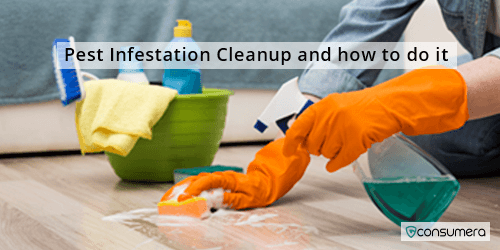Pest Infestation Cleanup And How To Do It
Published Date: January 10, 2024

Dealing with a pest infestation is nobody’s idea of a good time. Whether it’s pesky insects, creepy critters, or disease-carrying rodents, addressing the issue becomes paramount when signs of an invasion surface. Not only is it about getting rid of unwelcome guests, but it also involves cleaning up the aftermath they leave behind.
Here, we will provide valuable insights and practical tips on effectively cleaning your home after a pest infestation.
Pest Infestation Cleanup Tips
The intrusion of pests in our homes requires urgent attention and practical solutions. The cleanup, involving the disposal of pests and eradication of harmful residues, is a challenging task that extends beyond the surface. Neglecting this process results in an unsightly environment and poses health risks to the occupants.
Let’s check the practical tips for pest infestation cleanup.
- Determine the specific pest causing the infestation to plan your cleanup approach accordingly.
- Wear protective gear, including gloves and a mask, to prevent direct contact with pests and potential contaminants.
- Dispose of dead pests, nests, or hives, sealing them in a plastic bag to minimize contamination.
- Clean all surfaces with a mixture of water and mild detergent. Use disinfectants to eliminate bacteria and pathogens left behind by pests, preventing the spread of diseases.
- Identify and seal potential entry points to prevent future infestations.
- For severe infestations, seek help from pest control professionals, as they can provide thorough cleanup and preventive measures.
- Implement regular cleaning routines and maintain a clutter-free space to prevent pests from returning.
How To Clean Up After A Rat Or Mouse Infestation?
Dealing with a rodent infestation demands vigilance and a meticulous approach to cleaning, given the infectious viruses rodents may carry. The Centers for Disease Control and Prevention (CDC) offers valuable guidelines to ensure a safe and effective cleanup after a rat infestation.
- Spray or apply disinfectant or a mixture of water and bleach onto rodent droppings. Allow the treatment to work on the droppings before using paper towels.
- If you are dealing with a dead rodent, spray disinfectant and soak the corpse in a plastic bag. Ensure to seal it before disposing of the bag in a trash bin away from your home.
- After cleaning all the physical debris, mix bleach & hot water, and disinfect the surfaces that were exposed to rodent droppings or where the rodents may have come into contact.
- For items like books, documents, etc., that cannot be disinfected using the liquid, store the items in a disinfested area for a week or simply under the sun for a day.
How To Clean Up After A Raccoon Residue?
Cleaning up a raccoon residue works similarly to dealing with a rodent infestation. Raccoons may leave droppings, urine, or nesting materials, requiring a thorough and cautious approach to ensure a safe living environment.
- When dealing with raccoon feces, wear proper safety gear, including gloves and a mask.
- Mist the affected area with hot, soapy water to help control dust and minimize the risk of airborne contaminants.
- Wipe the area using a damp sponge and soap to clean surfaces. This step helps remove any remaining residue.
- Identify and seal potential entry points to prevent future raccoon intrusions. Inspect walls, floors, and openings carefully.
- For severe infestations, seek help from professionals for comprehensive cleanup and preventive measures.
How Do You Clean Up After An Insect Infestation?
Insects, regardless of size, can leave behind droppings that pose aesthetic concerns and potential health risks. Cleaning home after insect infestation accomplishes two things: first, it removes the residual germs and bacteria. Second, it eliminates pheromones and scents that attract other insects.
Some of the ways to clean up an insect infestation are mentioned below.
- Use appropriate tools (e.g., vacuum cleaners, tweezers) to remove visible insects from surfaces. Dispose of them in a sealed bag.
- Disinfect the surfaces where the insects and their droppings were present to eliminate any remaining bacteria or pathogens.
- Seal all potential entry points by addressing gaps under windows, doors, or walls using appropriate sealants.
Conclusion
Cleaning up after a pest infestation is a crucial step in restoring the safety and well-being of your home. Each step contributes to a comprehensive cleanup strategy, from disinfecting surfaces to sealing potential entry points.
If you need some aid in controlling or preventing pests from further entering your home, you can always dial professionals offering niche pest control & management services. Find out lots more about pest control companies on consumera.
FREQUENTLY ASKED QUESTIONS (FAQs)
Does Cleaning Help Get Rid Of A Pest Infestation?
Yes, cleaning is crucial in getting rid of a pest infestation. Regular and thorough cleaning helps eliminate the factors that attract pests, remove their food sources, and disrupt their habitats.
How Do I Clean Up After Pest Control?
After pest control, open windows to ventilate, clean surfaces and fabrics to remove any remaining pesticides, seal entry points, discard unsealed food, and check for pests to ensure a thorough cleanup.
How Do You Clean Up After A Rat Infestation?
For a rat infestation cleanup process, prioritize safety by wearing protective gear. Clean up rat droppings and debris with a vacuum cleaner, disinfect surfaces, and seal entry points to prevent future infestations.
How Do I Handle Rodent Droppings Safely?
Use disinfectant or a mixture of water and bleach on rodent droppings. Allow it to work before cleaning it with paper towels. Wear gloves and a mask for protection.
How Do I Handle Rodent Droppings Safely?
Use disinfectant or a mixture of water and bleach on rodent droppings. Allow it to work before cleaning it with paper towels. Wear gloves and a mask for protection.




